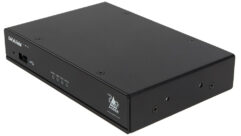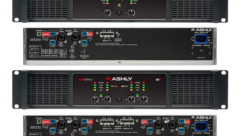HEAVY METAL, PART II
Jul 1, 2002 12:00 PM,
PETER H. PUTMAN, CTS
▪ IN THE JUNE 2002 ISSUE, I COVERED MY EXTENSIVE comparison tests of VHF and UHF antennas for signal reception and gain. That session took two days to complete, and once it ended, I thought, “Why not run a similar set of tests for indoor reception?” Armed with a bunch of aluminum and test equipment, I spent a full day evaluating indoor antennas — some amplified, some not — to see how well they pulled in analog and digital TV signals.
The location was the center room of my studio, which is where I normally test plasma monitors, projectors and other display devices. This office location is almost equidistant from a pair of DTV stations in Allentown, Pennsylvania, about 23 miles due north, and five DTV stations in Philadelphia, about 23 miles south. The view north is mostly unobstructed; however, a 50-foot hill and the four-story county courthouse block me to the south. It’s a pretty typical indoor DTV reception location.
Many of the antennas used in my first tests were unsuitable for indoor reception. Mostly they were too large; so I opted only for those models that could reasonably be used free-standing indoors or mounted to a wall bracket. I checked some of the antennas with and without an external UHF preamplifier. Signal levels are crucial for indoor DTV reception, and I don’t think it unreasonable to add a preamp if it can make the system work better. A Channel Master 7775 was the stockbox preamp tested with the Antiference Silver Sensor and two of my own compact yagi designs.
The receiver was a Samsung SIR-T150, with a small spectrum analyzer fed from its antenna loop output. The Sadelco MiniMax 800 was used to read signal strength in all modes (as far down as -20 dBmV in analog mode and -13.2 dBmV in digital mode). Reception for the carrier-to-noise tests was verified for at least three minutes using my reference Princeton AF3.0HD monitor.
RESULTS TABLES
All measurements in Tables 1-3 are dBmV levels. Signal levels that fell below the MiniMax 800 threshold sensitivity are simply listed as “<-20” for analog and “<-13.2d” for digital. This doesn’t mean they wouldn’t work with the tuner, just that they were pretty weak. Table 4 is the approximate carrier-to-noise measurement data. While not as accurate as precision lab data, it will give you a good idea of how strong each DTV signal was, and you’ll see notes indicating channels that showed moderate to severe multipath or intermittent reception. The DTV correction factor for each measurement has been applied.
▪ VHF Analog. There is direct correlation between an antenna’s physical size and its gain at a specific frequency. You can make antennas much smaller, but the active (driven) elements must resonate close to or at the wavelength of the desired frequency. Tricks such as capacitors, inductors and even winding antennas into coils and helixes have been used to reduce physical size while maintaining reasonable performance. The best performer in this category was the Radio Shack 15-1862 combo antenna. It uses a pair of rabbit ears and a rotatable UHF double loop against a mesh reflector. It has a variable-gain VHF/UHF preamp that isn’t too noisy, and the resulting gain figures are almost 6 dB better than the runner-up, Terk’s TV55 with the internal amplifier switched on.
The performance of this $60 antenna was quite a bit better than another, more expensive “designer” Radio Shack indoor antenna, the 15-1890 dipole/helix. The box for the 15-1890 is actually marked “High Definition Antenna,” but it doesn’t have a lot of gain on VHF channels in any mode. Without the internal amplifier, it’s pretty deaf. With it, it’s marginal.
The Antiference Silver Sensor went up against two of my own designs with and without a preamp, but because the antennas are designed to have little or no gain at VHF frequencies, they basically bombed out on this part of the test. (At least they aren’t susceptible to overload from a strong VHF station.)
▪ UHF Analog. I expected this part of the test to be a more closely fought battle, but once again the Radio Shack 15-1862 blew away the field on every analog channel. What’s more, its analog UHF signals looked pretty clean with a moderate amount of multipath that could be cleaned up by repositioning the double loop antenna. The 15-1890 was once again a bit of a disappointment, as the Channel Master 3000A and Terk TV55 both outperformed it on channels 26, 29, 39 and 48. Only on channels 57 and 69 did the antenna show a bit more gain.
The UHF-only antennas were pretty evenly matched across the band, with the unamplified Silver Sensor doing best on channels 17, 29 and 48, and either of the two ROAM antennas pulling out a little more signal on channels 39 and 57. Adding the external preamp didn’t change things much — the Silver Sensor still had the most gain on channels 17, 29 and 48, and the ROAM antennas were a bit more sensitive on 39, 57 and 69.
▪ UHF DTV. You might expect digital signal measurements to follow the analog signals, but use caution around that assumption: A signal strength meter cannot distinguish multipath from the true signal, and that would affect all of the readings in Tables 1 and 2. Just because a signal is strong doesn’t necessarily mean it is clean enough to be locked up by a DTV receiver. You could be measuring a strong multipath reflection, which is not usable.
Among the amplified antennas, the RS 15-1862 once again provided the most signal level across the band. (WHYY-55 was extremely weak and not possible to measure without a precision spectrum analyzer.) None of the other antenna configurations provided much signal except with channel 26 and channel 64, not coincidentally, the two strongest signals in the office, and the two running the most transmit power (787 kW and 500 kW ERP, respectively).
The 15-1890 didn’t yield much signal in any mode, except with KYW-26 and WPVI-64 when using the amplifier with either the internal dipole or helix antenna. Things were a bit tighter with the UHF-only antennas with and without the preamp. There was no clear advantage to any antenna except on channel 42, a signal that usually has lots of multipath. Because the ROAM yagis were designed for best SWR match and moderate multipath, they did a bit better here.
▪ DTV CNR. Each antenna was tested for actual reception of each of the seven DTV signals present. Successful reception required a steady 3-minute observation with no audio or video dropouts or hangups. The actual measurements are not very precise, but they are close, and they take into account the correction factor for measuring DTV waveforms.
In the amplified group, the 15-1862 swept the board, locking up each of the seven stations (two with moderate multipath) and receiving all just fine. The only other antenna to come close was the 15-1890 (surprise!) using the internal helix antenna and switching the amplifier on. While this antenna didn’t show much gain in the previous four tables, it did overcome moderate multipath to pick up the elusive WHYY signal.
The rest of the UHF antennas jockeyed back and forth through each channel with no clear victor. Because the antennas were directional yagi designs, their placement was much more critical, but once they were aimed correctly, plenty of signal was seen on the spectrum analyzer. The Silver Sensor had an edge on channels 46, 55 and 64, while my own yagis did a bit better on 26, 42, 62 and 67.
CHOOSE WISELY
Most of the antennas tested will do the trick for DTV reception, provided signal levels are strong enough. In most cases, you’ll need some kind of amplifier to get signal levels high enough for the DTV tuner’s equalizer to work with. The quality of internal and external amplifiers can vary quite a bit. The cartridge UHF preamp sold by Radio Shack for $39.95 is not very stable and a bit noisy, so spend a few more dollars and use a premium-grade version from Channel Master, Blonder Tongue or Winegard.
The “trick” antennas that save space will yield mixed results for DTV reception. The TV55 did okay on the lower UHF DTV channels (26 and 42), but was outperformed by the much smaller 15-1890 compact antenna from channel 46 on up. Even the rather pedestrian-looking 15-1862 cranked out some serious DTV signals on all channels, and it doesn’t take up much room.
If you are working with UHF signals only, then don’t bother with a VHF antenna. Maximize your gain where you need it the most. Similarly, choose a good design with lots of gain for VHF if that is where the signals are, and don’t worry too much about UHF performance. It’s a good idea to check into a compact spectrum analyzer such as those sold by Avcom, B&K and Blonder Tongue.
Peter H. Putman owns PHP Communications, Doylestown, Pennsylvania. The author of The Toastmasters Guide to Audio/Visual Presentations, he is a regular columnist in S&VC.
Table 4: DTV Carrier-to-Noise Measurements
Carrier to Noise (C/N) Measurements
L-Received on SIR-T150









